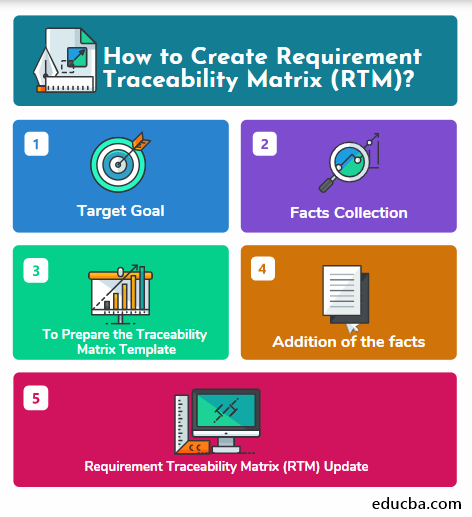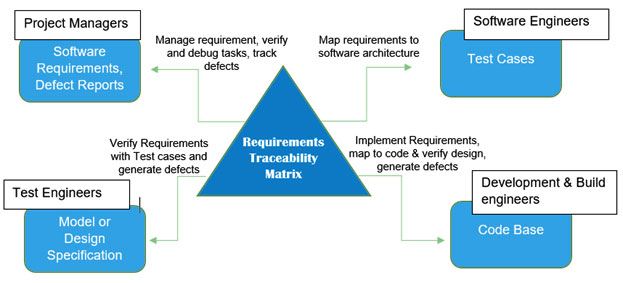
Overview of Requirement Traceability Matrix (Scope)
Requirement Traceability Matrix (RTM) is the basic building block for any software project. Requirement Traceability Matrix (RTM) is a document in a software development project which is used to validate all the requirements and their corresponding test cases. This Ensures that there is no miss in a project and all the requirements are covered while testing which is the basic goal of any testing project. In this topic, we are going to learn about Requirement Traceability Matrix (Scope).
The main focus of any testing team is to ensure the maximum test coverage; it simply means that everything in a project needs to be tested and Requirement Traceability Matrix (RTM) helps to ensure the same. The actual goal is to cover 100% scenarios/test cases. Requirement Traceability Matrix (RTM) is generally in a tabular form which basically involves to and fro relationships between requirements and test cases. Requirements are basically categorized into two sections:-
a. Functional requirements: These are basically the requirements that describe the behavior of the system. It has a relation to the functional aspect of the system.
b. Non-functional requirements: It is related to the performance characteristic of the system.
Importance of Requirement Traceability Matrix (RTM)
- The prime motive of every tester is to understand the client’s requirement and ensure that the output produced is defect free.
- In order to achieve it, one needs to understand the requirement thoroughly and create positive and negative test cases.
- In order to ensure that all the possible scenarios are considered in testing, we need the Requirement Traceability Matrix.
- This matrix is a complete summary of any project which is typically a worksheet containing all the requirements with its possible test scenarios. It also contains the current status of the testing.
- This helps the testing team understand the various levels of testing done for any particular product.
Parameters in Requirement Traceability Matrix (RTM)
The very basic Requirement Traceability Matrix (RTM) contains the below fields:-
- Unique ID for Requirement
- Requirement statement
- Type of Requirement
- Description of the Requirement
- Test Cases with its actual status
But there are a lot more parameters in the traceability matrix of a typical software testing project. Below are some of them:-
- To design Status as well as execution status for the specific test case
- Status of various phases of testing like IAT and UAT can also be captured in this matrix.
- Defects found and current status can also be mentioned in the same matrix.
This kind of matrix is the complete sheet containing data for all the testing activities.
Types of Traceability Test Matrix
Here are the Types of Traceability Test Matrix given below:
1. Forward
- Requirements of the project are mapped with the test cases.
- With this, the project goes a smooth move.
- Ensures thorough testing of the requirements.
2. Reverse or Backward
- It is used to map the test cases with the requirements.
- Ensures that the project scope is not extended by the addition of new functionality or features.
3. Bi-directional which is Forward + Backward
- When we create a document a document as a combination of forwarding Traceability and Backward Traceability it is termed as Bi-directional Traceability – where the mapping is done from the requirements to test cases and from test cases to the requirements.
- It’s good to have the test cases for each of the requirements and vice versa.
How to Create Requirement Traceability Matrix (RTM)?
Here are the following points for creating Requirement Traceability Matrix
1. Target Goal
Before we start anything we need to set the goal which gives us a clear picture of the task and in this case, it will help to know the purpose of the Requirement Traceability Matrix (RTM).
2. Facts Collection
- As the goal is decided, now the artifacts are needed in order to accomplish the goal.
- Following artifacts are needed in order to build a Requirement Traceability Matrix (RTM):- Requirements, Test Cases, Test Results and Bugs.
- The next step is to collect these artifacts. The latest version of the requirements is required and also corresponding test cases need to be collected from the testing team.
3. To prepare the traceability matrix template
Now the excel sheet is to be created and each artifact should be added in different columns.
4. Addition of the facts
- Now we can start adding all the artifacts in the excel sheet created.
- Need to ensure that each requirement, test case, and the bug should have unique ids.
5. Requirement Traceability Matrix (RTM) Update
- This is the continuous process until the end of the project lifecycle.
- Any change in the requirement needs to be updated here.
Advantages of Requirement Traceability Matrix (RTM)
- Highlights the missing requirements or document inconsistencies.
- All the possible test scenarios are covered.
- Shows overall defects and execution status with alignment to Business Requirements.
- Helps in proper versioning of the required documents.
- Requirement Traceability Matrix (RTM) helps in creating a snapshot to identify the gaps in the test case coverage from the project requirement.
Scope of Requirement Traceability Matrix (RTM) in any software project
- The below diagram depicts the importance of Requirement Traceability Matrix (RTM) in any software project. Requirement Traceability Matrix (RTM) helps in maintaining the record for each and every update/change in the project and hence creates an easy to track it whenever required.
- From the above diagram, we can easily figure out that each phase of the project is updated in the Requirement Traceability Matrix (RTM).
- Although Requirement Traceability Matrix (RTM) is just an ordinary Excel spreadsheet that contains the status of the requirements, test cases, design specifications, bugs, etc.
- One can tell the complete status of the software project by looking at this sheet.
- Also, just awareness of Requirement Traceability Matrix (RTM) is not enough if one is managing the requirements in a software development project but it is also important to have a thorough go through to the Requirement Traceability Matrix (RTM) document throughout the course of the software project.
Recommended Articles
This is a guide to the Requirement Traceability Matrix (Scope). Here we discuss the importance of requirement traceability matrix and the types of the traceability test matrix. You can also go through our other suggested articles to learn more –


